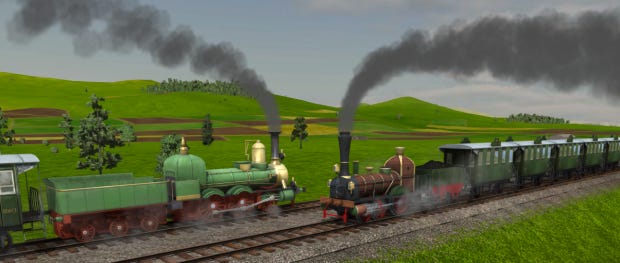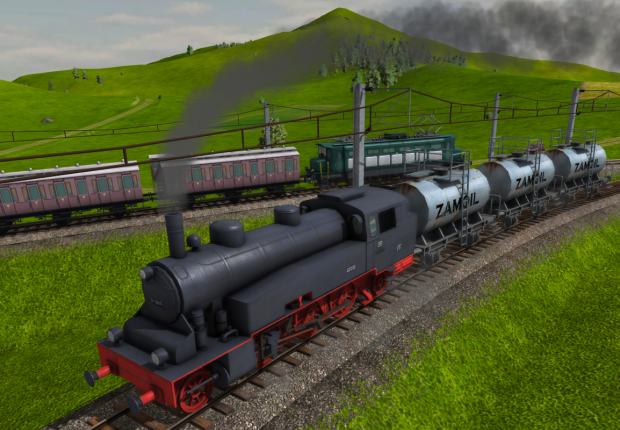Wot I Think: Train Fever
Yellow, scarlet, and dengue also available
In Train Fever you don't play Basil Batchley-Lytton, a Holmes-style epidemiologist investigating a gruesome skin disease sweeping Victorian Britain. Pressing 'h' doesn't hail the nearest hansom cab. Pressing 'm' doesn't bring up a microscope view. The climactic scene doesn't take place in the horsehair storeroom of the GWR upholstery shop in Swindon. Accept these crushing disappointments - recognise that £20 has secured you a compelling Transport Tycoon replacement with a few annoying yet surmountable flaws, rather than a fog-wreathed microbial mystery - and enjoyment is almost inevitable.
Made by five chaps from the unlucky Swiss city of Schaffhausen Train Fever is actually as interested in buses, trucks and trams as it is in trains. With long-distance rail line construction an expensive business, the early phases of most sessions tend to be dominated by bus stop placement and coach and cart purchasing. The randomly generated gridless maps are sprinkled with towns and industries. Entangle these loci in a net of mutually beneficial transport routes and settlements should grow while you prosper.
The simple premise is served by a clean, logical GUI, but that doesn't excuse the absurdly brief tutorials. Beginners are presented with half-a-dozen Post-it sized text pop-ups and expected to get on with it. Important information about economics and engineering is withheld. I spent my first couple of hours ferrying workers to inactive industrial sites not realising that the only things such sites required were links to markets and raw materials. After a week of experimentation, I'm still not entirely sure why some lines flourish and other apparently similar ones fail.
Economics might be less opaque if the game haloed its bus stops and railway stations with helpful catchment area circles. Urban Games explain that citizens of TF towns are persistent individuals with specific homes, workplaces, and recreational haunts. They point out that people will automatically travel between these locations using 'the cheapest and fastest' form of transport available, but they don't make it particularly easy to read the resulting passenger flows, identify network holes and over-provision, or tune systems for maximum efficiency. Combine instinct with observation and experience, and - on 'easy' or 'medium' difficulty at least - you will succeed in fashioning profitable transport empires, but it's unlikely initial bafflement will ever completely lift.
Tinged with inscrutability Train Fever is, thankfully, never short of momentum. New bus and truck lines rarely take more than a minute or two to set up (just position stops and depots, sequence them via the elegant line creation UI, and then assign appropriate vehicles). Even with fiddly track laying tools (more on which later) laying rail and sleeper isn't much more time-consuming. Like all good tycoon titles, one project invariably triggers another...
Now Crewe and Nantwich are linked by rail I really should add some extra station-feeding tendrils to Nantwich's bus network. And as the new line runs very close to that unexploited coal mine, perhaps a spur connecting colliery with steelworks would be sensible. Which means the steelworks will need ore. Time to extend truck route 'B' to take in...
Before you know it your coffee has gone cold, the fruit in the fruit bowl has blue stubble, and hover cars and jetpackists are buzzing past your window.
Train Fever's own timeline stops some way short of hover cars and jetpacks. The range of vehicles draws on 160 years of European transport history. The majority of locos, trucks, buses and trams are based on German and Swiss prototypes, but British and French designs also appear. Though modding is still in its infancy, early efforts suggest we will, eventually be able to play with country-specific vehicle sets.
Country-specific terrain may prove a taller order. Currently, the map generation screen is disappointingly short of buttons and sliders. Budding Brunels may choose between three map sizes , three hilliness settings, and three starting dates (1850, 1900, 1950) but there's no way to give venues a tropical or Mediterranean flavour, say, or specify tree or water coverage percentages. Terrain is available in any colour as long as it's green and is never shrouded by snow or fallen leaves. Perhaps unsurprisingly given their name, Urban Games seem more interested in providing charismatic towns than charismatic countryside. Clever procedurally generated architecture mean town skylines are unusually diverse.
Townscapes grow and change spontaneously over time; often you end up altering them through building demolition and road building too. The latter activity is complicated somewhat by Train Fever's annoyingly fussy track building regulations. Want to create a level-crossing by running a road across a railway line? You'll need to scrap the track first. Want to create a diamond junction or carry a railway over a railway using a bridge? Good luck with that. The game's invisible navvies are at their most recalcitrant when tunnel digging and elevation changes are needed. Even fairly small height transitions can cause problems.
The devs claim they are merely reflecting real-life physics but in a game where locos use teleportation rather than turntables to change direction at branchline termini, and bulldozing a major trunk road in order to force punters to use railways is possible, citing realism seems a tad rich.
Another annoyance that needs prompt attention is vehicle replacement. As it stands vehicles have limited life expectancies. When they hit a certain age their maintenance costs start spiralling and a message pops up recommending withdrawal. Withdrawal involves recalling the museum piece to a depot then selling it, buying something new and assigning the purchase to the appropriate line. Written down it doesn't sound particularly onerous, but when you've got hundreds of vehicles beetling round a map the task rapidly becomes tiresome and distracting. A 'maintenance cost cap' tickbox on the options screen would be a welcome interim solution.
Train Fever is pure solo sandbox at the moment. The freedom is splendid but the time may come when you find yourself yearning for a soupçon of structure or a pinch of friction. Optional dynamically generated side tasks linked to vehicle unlocks or temporary construction privileges would have been an interesting inclusion, as would competing AI entities or multiplayer. The growth of towns and the march of time does slowly alter the challenge (In the second half of the 20th Century increasing car ownership creates congestion and threatens profits) but apart from these factors and the extra workload generated by a larger transport network, the feel of early eras isn't dramatically different from that of late ones.
Train Fever is a little under-equipped and clumsy in places, but its economic model makes sense, its ceaseless transport networks are a pleasure to ponder, and its constant encouragement to build and buy is incredibly hard to resist. If you're in the mood for a rail-related mallardy and have already got tuberculosis, tendernitis, and wagonorrhea then it's unlikely you'll regret your purchase.
Train Fever is out now and costs £20.



















